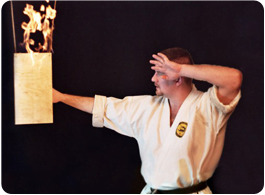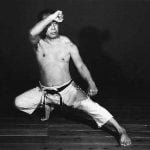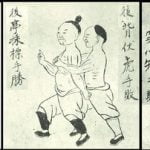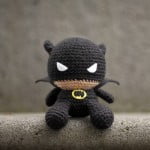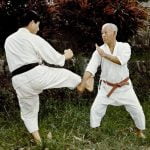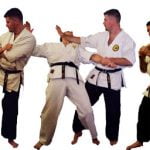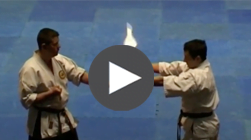Iha Sensei’s Study with Gusukuma
In 1950, Seikichi Iha was accepted to begin the formal study of karate with Shinpan Gusukuma (the kanji of his family name are also pronounced “Shiroma” in Japan), a student of Anko Itosu, at his dojo in Shuri City. Shinpan Gusukuma was well educated-working as a school teacher and also known for his skills as an acupuncturist. A student of Anko Itosu, 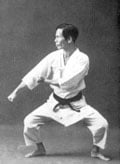 Shinpan Gusukuma also studied under many other master teachers in different styles. He selected Shorin-ryu as his primary interest. Sensei Iha explains that in the past, Okinawan karate students might study with a variety of teachers. Someone would hear about a person who was good at a particular kata or technique and then go ask that person to teach him.
Shinpan Gusukuma also studied under many other master teachers in different styles. He selected Shorin-ryu as his primary interest. Sensei Iha explains that in the past, Okinawan karate students might study with a variety of teachers. Someone would hear about a person who was good at a particular kata or technique and then go ask that person to teach him.
Iha notes that due to Gusukuma’s schedule as a school teacher-teaching a few hours every day with summers off-he was able to concentrate on advancing his own practice of karate. A friend of Iha’s encouraged him to begin karate with Gusukuma who, at that time, was in his 60’s.
Getting There
Twice a week after work, Iha walked two hours from his home in Nishihara to the Gusukuma dojo. Iha often didn’t have a chance to eat before leaving for class. He’d attend class and walk the two hours back home. Whenever possible, students would bring whatever food they had to share. In 1953, the year before he died, Gusukuma moved the dojo to Naha which was an even longer walking distance for Iha – all the way to the west coast of the island.
At this time in Okinawa, Sensei Iha explains, walking was just about the only way to get from place to place. Car travel was difficult-the roads were so narrow in places a driver would have to back out if someone came the other way. Even if a person had access to a car, gas wasn’t easy to find. Any travel required a lot of planning so most people didn’t go far from their homes-but there were many who dreamed about being able to travel the island in their lifetime. Gusukuma was one. Iha tells a story about when his teacher decided to walk to the northern tip of the island-a difficult task since there were few roads in that part of the island then. To do this, Sensei Gusukuma had to write out his itinerary for every day of walking, contact people and arrange where to send food in advance. Planning took a couple of years.
The Gusukuma Dojo
Iha remembers Sensei Gusukuma’s dojo at Shuri as being a very small room. Only one student could demonstrate kata in front of him at a time. Students might often have to back up from the wall to complete a kata. There could be as many as 6 or 7 students in a class waiting for a turn to show their teacher the “homework” lessons they had been practicing. Gusukuma’s later dojo in Naha was larger- a “three tatami” room (approx. 9′ x 9′).


Strong Mind, Strong Body
Gusukuma practiced Zen concentration and could maintain intense focus of his thoughts for long periods of time. He would often be completely absorbed in a game of Go (Chinese chess) when Iha arrived for class. Not wanting to disturb his teacher, Sensei Iha remembers practicing karate and leaving without Gusukuma breaking concentration on his game. His teacher asked him at the next class, “Why didn’t you come to class last time?”
Iha describes Gusukuma as being extremely agile (“like an Olympic gymnast-he could do three spins from a bar hanging from his arms”) and able to focus his punches so that 100 pounds of body weight could exert 300 pounds of power. This power was achieved through daily training of hands and feet using the makiwara punching board. He would often say that if you see someone you think is skilled and want to be as good as them, watch how they practice. If they practice something 10 times, you must practice it 100 times. Iha recalls that Gusukuma’s constant practice of spear hand techique (nukite) by striking bundles of bamboo had caused the nails to drop off all his fingers.
Traditional Learning-One Step At a Time
After each class, Sensei Iha recalls that he would go home and work on his karate homework for a couple days or more-returning to class only when he felt he could successfully demonstrate the lesson his teacher had given him. Sensei Gusukuma expected his students to intensively study and learn one thing at a time. Learning new material progressed slowly and methodically and required students to really learn and practice each new concept in great depth, then demonstrate their knowledge before moving on to the next lesson. One class might be only half of one pinan kata with the next class or more working on the same thing over and over again. (At this time in the Okinawan dojos, first year students might typically only learn Kihon Kata 1-3 and Naihanchi.)
The following story was related to Sensei Iha by Shinpan Gusukuma and Iha has retold it to his bo students to point out the importance of patience and practice. Shinpan Gusukuma went to Japan on his summer school teaching break. While there he wished to train in the naginata. He met with a teacher and explained what he wanted to learn. She showed him how to do the nuki (spear thrust) and told him to practice this technique 2 to 3 hours a day. Every day when he came to the teacher’s dojo, she told him to practice the nuki technique, then she left. He practiced like this for his entire vacation. When it was time to return home, he asked his teacher how long it would take for the average student to learn the nuki and be able to go on to the next technique. She replied, “Oh, usually three years.”
These personal stories were related by Seikichi Iha to his students during the fall and winter of 2000-2001 recounting his years of study with Shinpan Gusukuma.
Gusukuma Shinpan (Shuri-te)
One of Yasutsune “Ankoh” Itosu’s students was Gusukuma Shinpan (1890-1954) who was also a peer of Chibana Choshin. Gusukuma, also called Shinpan Shiroma by the Japanese, is virtually unknown due to the fact that he was a very quiet individual who was not interested in spreading the art that he so loved. His only concern was to teach good karate and hence only had a few dedicated students.
Shorin-ryu Training In The 1950’s
Although a peer of Chibana Choshin, very little is said about the master technician, Gusukuma Shinpan. He began teaching shortly after WWII and was close friends with Miyagi Chojun, Kyoda Jyuhatsu and Kyan Chotoku. He taught regularly at Shuri Castle and had a dojo at his home in Nishihara City. He was a school teacher by profession but his first love was Shuri-style karate.
One of his former students was Iha Seikichi (who presently resides in East Lansing, Michigan) who often talks about his teacher. The following are some thoughts concerning how it was like to train in the l950’s under Gusukuma:
Training under Gusukuma-sensei was very strict and traditional. It was a lot of self-training where he would watch to see how hard you wanted to learn. All students would first become an apprentice student and help clean the dojo for six months to a year. They could watch training but could not take part in receiving instructions.
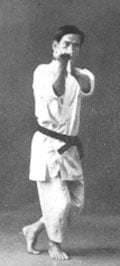 When Gusukuma-sensei thought that they were ready, he would then tell them to join in. Sensei never actively taught but would have the senior students do all the teaching. Sensei would only teach the top two or three students and then have them pass on the knowledge. This was a very traditional way of teaching.
When Gusukuma-sensei thought that they were ready, he would then tell them to join in. Sensei never actively taught but would have the senior students do all the teaching. Sensei would only teach the top two or three students and then have them pass on the knowledge. This was a very traditional way of teaching.
During class, sensei would evaluate every student and advise them of their weaknesses. He would allow each student to demonstrate two kata for him while he watched. Sensei would then tell them that they needed work on their stances, or their power, etc. They would then train themselves based on sensei’s evaluation. Sensei would sometimes show a student a technique and then say, “Ha, I showed you something! You are very lucky I did this! Now go train!!!”
Gusukuma-sensei would personally teach the top two or three senior students and it was then their responsibility to pass on the methods to the rest of the students. One senior would always be there to teach while sensei observed or trained by himself. Sensei was about 5’1″ and weighed about 125 pounds. He was extremely strong and trained his fists and toes on the makiwara everyday. He believed a karate-man must be able to generate power equivalent to three times their own body weight with either fist or foot. Needless to say, the students were constantly repairing the makiwara punching boards.
If a student did not train hard, Gusukuma-sensei would tell him that he should leave and come back when he was ready to train. If the student continued with this attitude, Gusukuma-sensei would tell him not to come back unless he was serious about learning and training. Sensei was hardest on students that did not listen. He had a good memory and would often tell a student to work on his punch or kick or kata. If the student did not do this then sensei would bring it to their attention and kick him out of the dojo for wasting his time by not listening.
Makiwara Training
All styles of Okinawan karate-do stress the importance of the makiwara board. It is said that training with the makiwara develops power through concentration of technique. This ability to “focus” is external power developed internally. Through constant training with the makiwara the student starts developing confidence in their technique. They see that it is stronger than those that have just started and find that through this confidence they are really able to punch and kick harder.
This is the usual difference found in Okinawan karate as opposed to the others. Their focus is on power – and the power is extracted from the makiwara. A lot of people can look good punching the air but their power can be seen as lacking or in some cases, non-existent. So, through makiwara training, one can readily see the power generated by training with these ancient pieces of equipment.
Gusukuma Shinpan stressed and possessed great power for a man of his size (approximately five feet tall). He believed in being able to hit the makiwara with the equivalent of three times your own body weight. So, if one weighed approximately one hundred pounds, Gusukuma felt that this individual must be able to hit with approximately three hundred pounds of force.
Gusukuma strived to developed this kind of power with both hands and both feet. He kept this level of power through training with the makiwara board and striking it approximately 300 times per day with each weapon. He was a firm believer that a measure of a karate person was in their ability to produce this kind of power.
Teaching Methods
Gusukuma’s teaching methods consisted of kata, kata and more kata. He believe that kata provided the foundation of the body and spirit. He said that the Japanese sword is sharp and beautiful but that in order to get to this end (that is, sharp and beautiful) it must be pounded and tempered with the sweat of one’s body. So the teacher must do the same to the student. If the student is dedicated to the hard training of Okinawan karate, then he can be molded into something sharp and beautiful. After all, Okinawan karate-do, if done correctly, is “sharp and very beautiful” to watch. And like a sharp and beautiful Japanese sword, it is also very deadly.
Techniques
In the kata kusanku-dai, in the kick and the drop down technique, Gusukuma stood supreme. He could kick and travel about eight feet before he dropped down.
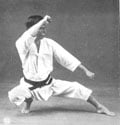 Gusukuma changed a number of Itosu’s kata and techniques to coincide with his own personal “enlightenment.” He stated that this is a common practice by all karatemen and that it is merely based on human nature to try and improve what one has learned. Gusukuma Shinpan had no fingernails because of his constant practice of the spear hand technique (nukite) on the bamboo bundles that he used as training aids.
Gusukuma changed a number of Itosu’s kata and techniques to coincide with his own personal “enlightenment.” He stated that this is a common practice by all karatemen and that it is merely based on human nature to try and improve what one has learned. Gusukuma Shinpan had no fingernails because of his constant practice of the spear hand technique (nukite) on the bamboo bundles that he used as training aids.
The Bus Driver
In Okinawa, one of Gusukuma’s students was a bus driver. One time a drunk got on board the bus and started to cause trouble with the passengers by trying to pick a fight. The student yelled at the drunk, “do you really want to fight?” The drunk was quick to take up the challenge and demanded to fight now. The student then said that he would be more than glad to show him his fighting prowess. At this the drunk became very angry and demanded that the driver open the door so that they could go at it. When the door opened the drunk stormed off and readied himself by taking off his coat. As the drunk got off, the student just simply smiled, quickly closed the door of the bus and drove off with the drunk in hot pursuit. After a several hundred feet run, the drunk fell and threw up on himself. The driver had nothing to prove to the drunk or to himself. All the passengers laughed and told the bus driver that he had used good strategy.
Gusukuma’s Family
Gusukuma Shinpan has three sons and one daughter that are still alive today. During WWII he received a severe concussion from the American bombing that continued to bothered him for the rest of his life. He use to have severe headaches centered around the back of his right ear. The first son is presently a school teacher, the second son is handicapped from falling three stories on his back and his last son is presently a fireman. None of Gusukuma’s sons have equalled their father in his karate skill but the first and the third son are strong enough to teach. None do.
Dying
Gusukuma Shinpan always told his students that he would refuse to become bedridden or get to a point where he could not take care of himself. On the day of his death, he taught class and trained for two hours. He ate a light dinner and went to bed early. Three hours later, when his wife checked in on him, they found that he had died in his sleep. That day his students stated that Gusukuma had spoken of his own death. He had said, “My body is strong but everyday my will gets even stronger. I will pick my day and die at peace with no long illness or discomfort for my family. Wait and see.”
Gusukuma The Teacher
Gusukuma Shinpan was a school teacher and very educated while Chibana Choshin never finished high school. He saw the practice of karate as a hobby and never accepted payment for lessons. It should be noted that the common way of paying an instructor during the 1930s, 1940s and 1950s was to bring food for all to share after training.
Guskuma’s Trip To Japan
Just before the war and when Gusukuma Shinpan was in his prime he vacationed in Japan and saw a martial arts demonstration. He watched a group of female yari (spear) experts who had a dojo by his home in Tokyo. He was so impressed by their focus that he decided to take lessons in the yari from the female Sensei.
Gusukuma then went to her dojo and requested lessons. He also stated that he would only be in Japan for about three months because he was a high school teacher in Okinawa and that he had to return to teach. The teacher then gave him a wooden yari and showed him how to perform “nuki” (a spear thrust). He was then told to practice for about two or three hours.
Gusukuma continued to go to the dojo every day for three months and the only technique he practiced was the “nuki.” Just before he returned to Okinawa, he asked the Sensei if he was doing well and whether he should practice other techniques. She replied that he was doing well but that he needed more practice before he could learn another technique. He then asked her what was the average time it took to go on to another technique. She replied, “about three years.”
At the end of his stay in Japan, Gusukuma once again approached his Sensei to advise her he was returning to Okinawa. He thanked her for her time and stated that he would continue to practice and would be back next year.
She then took a long look at the great Gusukuma and said, “I’m glad that you’ll continue to practice. We all need to do this in order to learn the WAY. Thank you for your efforts and good-bye.” She then walked away.
Gusukuma’s Considerations
Gusukuma Shinpan often spoke of the eight consideration in kicking and the four considerations of the punch.
Considerations for kicking:
1. When kicking in kata or kumite, the back must be straight and true so as to allow you to punch if blocked.
2. The quickest kicks are of the snapping variety.
3. The kata kicks are performed with the toe-tipped foot.
4. The most important kick is that done to the chudan (middle) area.
5. Consider the knee the “hinge” of the kick.
6. The ankle must be strong in kicking as the wrist is strong in punching.
7. The leg is loose and flexible while the toes are tight. Just like a punch, the arm is loose while the fist is tight.
8. When kicking, kick with both legs.
Considerations for punching:
1. The large knuckle finger and the thumb squeeze the index finger in a good fist.
2. In making a strong fist, the index finger is folded first.
3. Punching is done with a loose arm and tight fist.
4. You strike with the index knuckle first.
Written by and submitted courtesy of Ernest Estrada, Okinawa Shorinryu Kyoshi
by E. Estrada sensei

